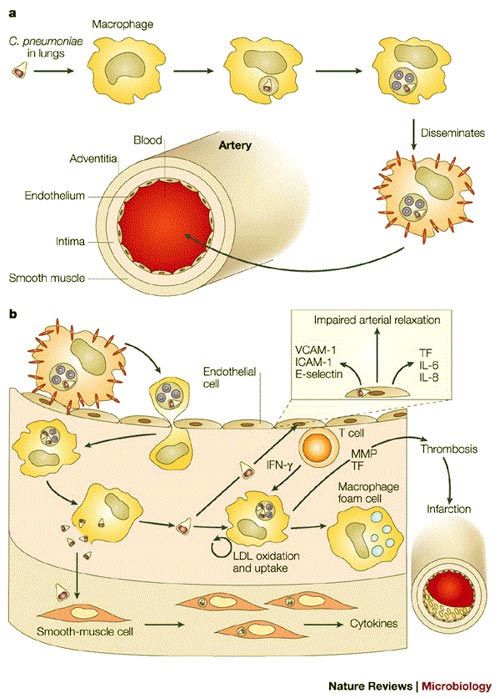
Chlamydia Pneumoniae cause arteriosclerosis?
If bacteria are responsible for atherosclerosis? In recent years a number of scientific studies have been published, suggesting that development of atherosclerosis pneumoniae could also be explained due to chronic infection with the pathogen Chlamydia. This bacteria-like pathogen can cause chronic infections of the respiratory system running. Only in 1995 his involvement in atherosclerotic changes in vessels of heart disease was discovered. This involvement of Chlamydia pneumoniae in atherosclerosis has now been proved beyond reasonable doubt. Whether the pathogen is the main cause of the disease but can not be said. He might as well be only one aspect of the classical concept formation. Chlamydia can be absorbed in the lungs of immune cells. It is for the involvement of Chlamydia in an explanatory model of atherosclerosis. The pathogen Chlamydia pneumoniae infects the respiratory tract. The immune cells, the macrophages are alarmed and begin to speak routinely dispose of the inhaled foreign body. The pathogen Chlamydia pneumoniae is added to the macrophage and "hiding" there. The Court has developed the ability to survive in the macrophage and multiply. Enter these cells via the blood circulation into the arterial vascular system, causing chronic inflammation of chlamydia in the vessel walls, leading to the familiar processes of fat and protein deposition in the vessel wall. Because the pathogen can multiply in this environment very well, then whenever a defense cell bursts due to "overloading", again released a torrent of pathogens. Then, each time again attracted new immune cells, the "full feed" is back with chlamydia. The burst also means that the encrustations of release of the vessel wall. They can then be transported over the blood flow and cause other parts to a vessel occlusion.
Many research results support the theory. For this theory to talk some facts that would otherwise be difficult to classify:
Previously unexplained phenomena are explainable. The significance of infection with Chlamydia pneumoniae in the development of atherosclerosis is supported by some, yet difficult to explain phenomena: The previously unexplained decline in atherosclerosis since 1965 would be explained by since the passing through antibiotic therapy for bacterial diseases. The lower rate of heart attack in France, which was previously interpreted as an effect of red wine, can be explained by the higher antibiotic consumption there. Occurring during a heart attack signs of inflammation can be explained as a sign of chronic infection. The increased frequency of heart attacks in males would be associated with the accumulation of bacterial infections in men. There are also contradictions. However, can also be found arguments against the theory of infection. In developing countries, for example, atherosclerosis is rare, even though there the pathogen Chlamydia pneumoniae is particularly frequent. One reason for this apparent contradiction could be that in primitive sanitary conditions in childhood to a first infection with Chlamydia pneumoniae is, however, which affects the digestive tract. Then formed in these children have partial immunity to the pathogen. In developed countries it is often made in later childhood through to early adulthood to an infection, which then affects the airways and leads to a systemic infection that spreads to the blood vessels. Antibiotic therapy is currently advocated only for high risk patients. Currently, extensive studies should be performed, the involvement of Chlamydia pneumoniae in atherosclerosis to examine more closely and ensure therapeutic measures. Judging from the participation of the pathogen, it must be considered a treatment with antibiotics as a consequence. As this therapy looks specifically how long they must be, how high the risk of developing resistance, etc., is currently being determined in long-term studies. Nevertheless, various doctors advocate today, weighing all risks of antibiotic therapy in high risk patients.
|
|
© 2014 "chlamydia-pneumoniae.org". All Rights Reserved |
